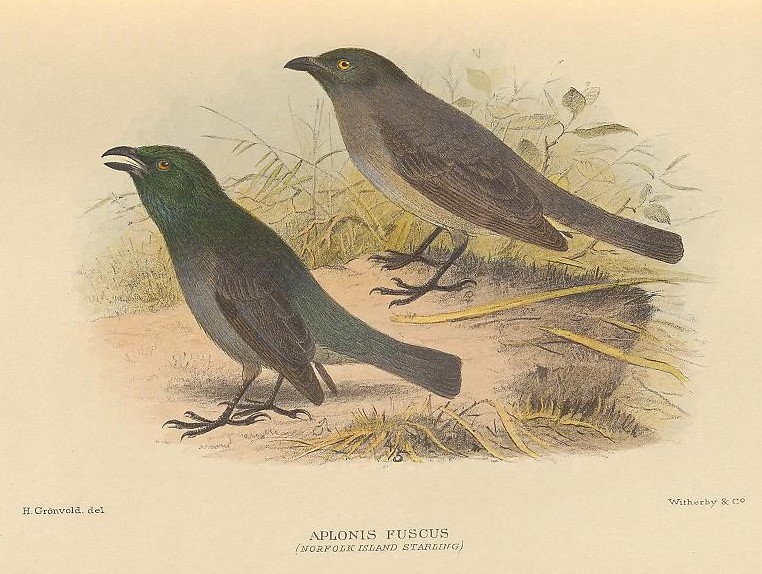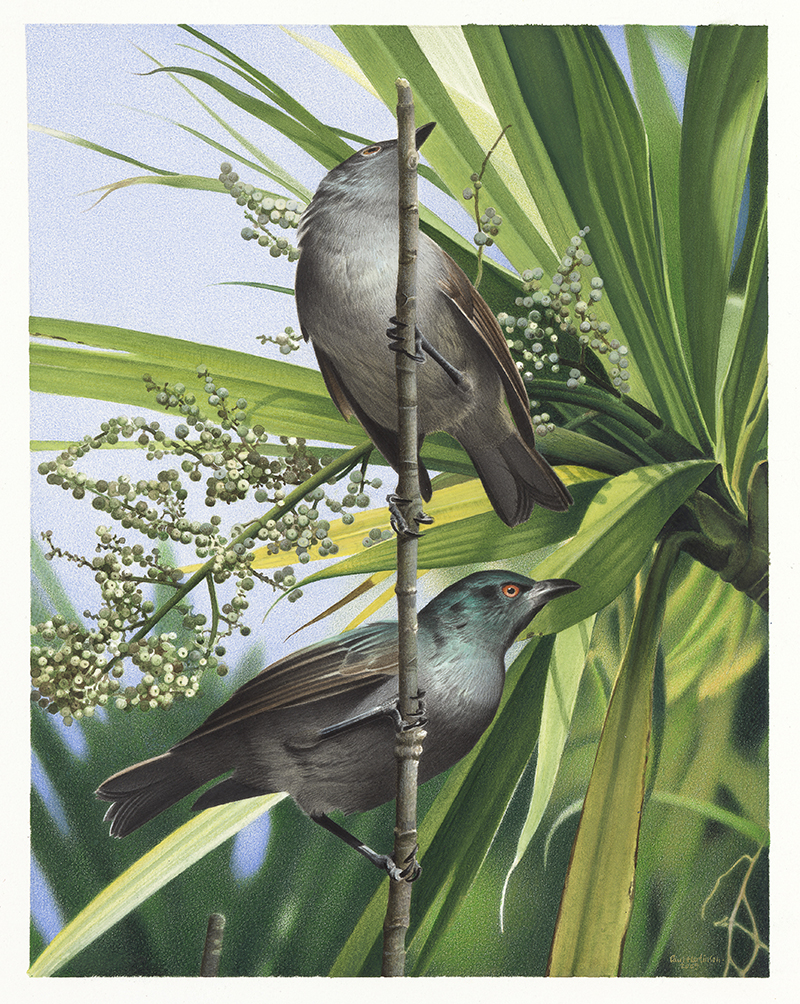Aplonis fusca fusca Gould, 1836:73
Norfolk Island starling, Norfolk starling
Taxonomy & Nomenclature
A complete synonymy taken from (Checklist Committee (OSNZ), 2010:314-315):
Aplonis fusca Gould, 1836: Proc. Zool. Soc. London 1836 (4): 73 – “Murrumbidgee, in Novâ Hollandiâ Australi”, error for Norfolk Island (fide Mathews 1928, Birds Norfolk & Lord Howe Islands: 54).; Aplonis fuscus Gould; Sharpe 1890, Cat. Birds Brit. Mus. 13: 133. Unjustified emendation.; Aplonis fuscus fuscus Gould; Mathews 1912, Novit. Zool. 18(3): 451. Unjustified emendation.; Aplornis fuscus Gould; Mathews 1946, Working List Aust. Birds: 145. Unjustified emendation.; Aplonis fusca fusca Gould; Schodde & Mason 1999, Directory Australian Birds. Passerines: 653.; Aplornis fusca Gould; Christidis & Boles 2008, Syst. Taxon. Australian Birds: 39.
Conservation Status
Extinct (WCMC, 1992:213)
Last record: 1923 (Garnett, 1992:185; Tyrberg, 2009:103); 1925 (WCMC, 1992:213); 1940's (Kittelberger et al., 2024)
IUCN RedList status: Extinct
Distribution
Norfolk Island, Australia
Biology & Ecology
Hypodigm
[url=http://nlbif.eti.uva.nl/naturalis/detail.php?lang=uk&id=29]RMNH 110.034[/url] (juvenile) [subspecies unknown]
Media

Above: illustration from Mathews (1928).

Above: Norfolk Island Starling. Aplonis fusca. From the series: Extinct Birds of New Zealand., 2005, Masterton, by Paul Martinson. Purchased 2006. © Te Papa. CC BY-NC-ND 4.0. Te Papa (2006-0010-1/9)
References
Original scientific description:
Gould, John. (1836). [Untitled: On two new species of birds, constituting a new genus]. Proc. Zool. Soc. Lond. 1836: 73-74.
Other references:
Anonymous. (1964). List of rare birds, including those thought to be so but of which detailed information is still lacking. IUCN Bulletin 10(Special Supplement): 4 pp.
BirdLife International. (2012). Aplonis fusca. In: IUCN 2012. IUCN Red List of Threatened Species. Version 2012.2. (http://www.iucnredlist.org). Downloaded on 23 May 2013.
BirdLife International. 2016. Aplonis fusca. The IUCN Red List of Threatened Species 2016: e.T22710511A94249210. https://dx.doi.org/10.2305/IUCN.UK.2016-3.RLTS.T22710511A94249210.en. Accessed on 02 July 2022.
Brooks, T. 2000. Extinct species. In: BirdLife International (ed.), Threatened Birds of the World, pp. 701-708. Lynx Edicions and BirdLife International, Barcelona and Cambridge, U.K.
Butchart, Stuart H. M., Lowe, Stephen, Martin, Rob W., Symes, Andy, Westrip, James R. S. and Wheatley, Hannah. (2018a). Which bird species have gone extinct? A novel quantitative classification approach. Biological Conservation 227: 9-18. https://doi.org/10.1016/j.biocon.2018.08.014
Butchart, Stuart H. M., Wheatley, Hannah, Lowe, Stephen, Westrip, James R. S., Symes, Andy and Martin, Rob W. (2018b). Data for: Which bird species have gone extinct? A novel quantitative classification approach. Mendeley Data, V1, doi: 10.17632/vvjhpmyxb4.1
Checklist Committee (OSNZ). (2010). Checklist of the Birds of New Zealand, Norfolk and Macquarie Islands, and the Ross Dependency, Antarctica (4th ed.). Ornithological Society of New Zealand & Te Papa Press, Wellington. [p. 314-315]
Christidis, L. and Boles, W.E. 2008. Systematics and Taxonomy of Australian Birds. CSIRO Publishing, Collingwood, Australia.
del Hoyo, J., Collar, N.J., Christie, D.A., Elliott, A., Fishpool, L.D.C., Boesman, P. and Kirwan, G.M. 2016. HBW and BirdLife International Illustrated Checklist of the Birds of the World. Volume 2: Passerines. Lynx Edicions and BirdLife International, Barcelona, Spain and Cambridge, UK.
Fisher, Diana O. and Humphreys, Aelys M. (2024). Evidence for modern extinction in plants and animals. Biological Conservation 298: 110772. https://doi.org/10.1016/j.biocon.2024.110772
Fuller, Errol. (1988). Extinct Birds. New York: Facts on File Publications. 256 pp.
Garnett, Stephen (ed.). (1992). Threatened and Extinct Birds of Australia. RAOU Report Number 82. 212 pp.
Garnett, S. T. and Crowley, G. M. (2000). The Action Plan for Australian Birds 2000. Canberra, ACT: Environment Australia & Birds Australia.
Garnett, S. T.; Szabo, J. K.; Dutson, G. 2011. The Action Plan for Australian Birds 2010. CSIRO Publishing, Collingwood.
Hermes, N. (1985). Birds of Norfolk Island. Norfolk Island: Wonderland Publications. 65 pp.
Hindwood, K. A. 1940. The birds of Lord Howe Island. Emu 40: 1-86.
Holdaway, Richard N. and Anderson, Atholl. (2001). Avifauna from the Emily Bay settlement site, Norfolk Island: A preliminary account, pp. 85-100. In: Anderson, Atholl and White, Peter (eds.). Records of the Australian Museum, Supplement 27. Sydney: Australian Museum.
Hull, Arthur Francis Basset. (1909). The birds of Lord Howe and Norfolk Islands. Proceedings of the Linnean Society of New South Wales 34: 636-693, pls. l-liv. [p. 691]
Kittelberger, Kyle D., Tanner, Colby J., Buxton, Amy N., Prewett, Amira and Şekercioğlu, Çağan Hakkı. (2024). Correlates of avian extinction timing around the world since 1500 CE. Avian Research 15: 100213. https://doi.org/10.1016/j.avrs.2024.100213 [Supplementary data (List of 216 taxa)]
Knox, Alan G. and Walters, Michael P. (1994). Extinct and endangered birds in the collections of The Natural History Museum. British Ornithologists' Club Occasional Publications 1: 1-292. [pp. 264-267]
Mathews, Gregory Macalister. (1928). The Birds of Norfolk & Lord Howe Islands and the Australasian South Polar Quadrant: with additions to "birds of Australia". London: H.F. & G. Witherby. xii + 139 pp., pls. 1-45. [p. 54, pl. 28]
Mathews, G. M. (1938a). Overlooked names of European birds from the 'Analyst' and from the 'Ornithological Guide'. Ibis 14(2): 321-331. [relevant citation?]
Mathews, G. M. (1938b). Aplornis versus aplonis. Ibis 14(2): 342.
Mathews, G. M. (1945). Notes on generic names. Emu 44: 319-320.
Sayol, Ferran, Steinbauer, Manuel J., Blackburn, Tim M., Antonelli, Alexandre and Faurby, Søren. (2020). Anthropogenic extinctions conceal widespread evolution of flightlessness in birds. Science Advances 6(49): eabb6095. https://doi.org/10.1126/sciadv.abb6095 [Supplementary Material (Data File S1)]
Schodde, R., Fullagar, P. and Hermes, N. (1983). A review of Norfolk Island birds: past and present. Australian National Parks and Wildlife Service, Canberra.
Scott, Peter (ed.). (1965). Preliminary List of Rare Mammals and Birds, pp. 155-237. In: The Launching of a New Ark. First Report of the President and Trustees of the World Wildlife Fund. An International Foundation for saving the world's wildlife and wild places 1961-1964. London: Collins.
Smithers, C. N.; Disney, H. de S. 1969. The distribution of terrestrial and freshwater birds on Norfolk Island. Australian Zoologist 15: 127-140.
Stone, W. & Mathews, G.M. 1913. Additional species described by Gould from Norfolk, Lord Howe, and Philip Islands. Austral Avian Records 1: 182-183.
Tyrberg, Tommy. (2009). Holocene avian extinctions, pp. 63-106. In: Turvey, Samuel T. (ed.). Holocene Extinctions. Oxford, UK & New York, USA: Oxford University Press. xii + 352 pp.
WCMC (World Conservation Monitoring Centre). (1992). Global Biodiversity: Status of the Earth's living resources. London: Chapman & Hall. xx + 594 pp.
Woinarski, John C. Z., Braby, M. F., Burbidge, A. A., Coates, D., Garnett, S. T., Fensham, R. J., Legge, S. M., McKenzie, N. L., Silcock, J L. and Murphy, B. P. (2019). Reading the black book: The number, timing, distribution and causes of listed extinctions in Australia. Biological Conservation 239: 108261. https://doi.org/10.1016/j.biocon.2019.108261
Woinarski, John C. Z., Legge, Sarah M. and Garnett, Stephen T. (2024). Extinct Australian birds: numbers, characteristics, lessons and prospects. Emu 124(1): 8-20. https://doi.org/10.1080/01584197.2023.2240345
https://extinctanimals.proboards.com/thread/8839/aplonis-fusca-ssp-norfolk-starling
